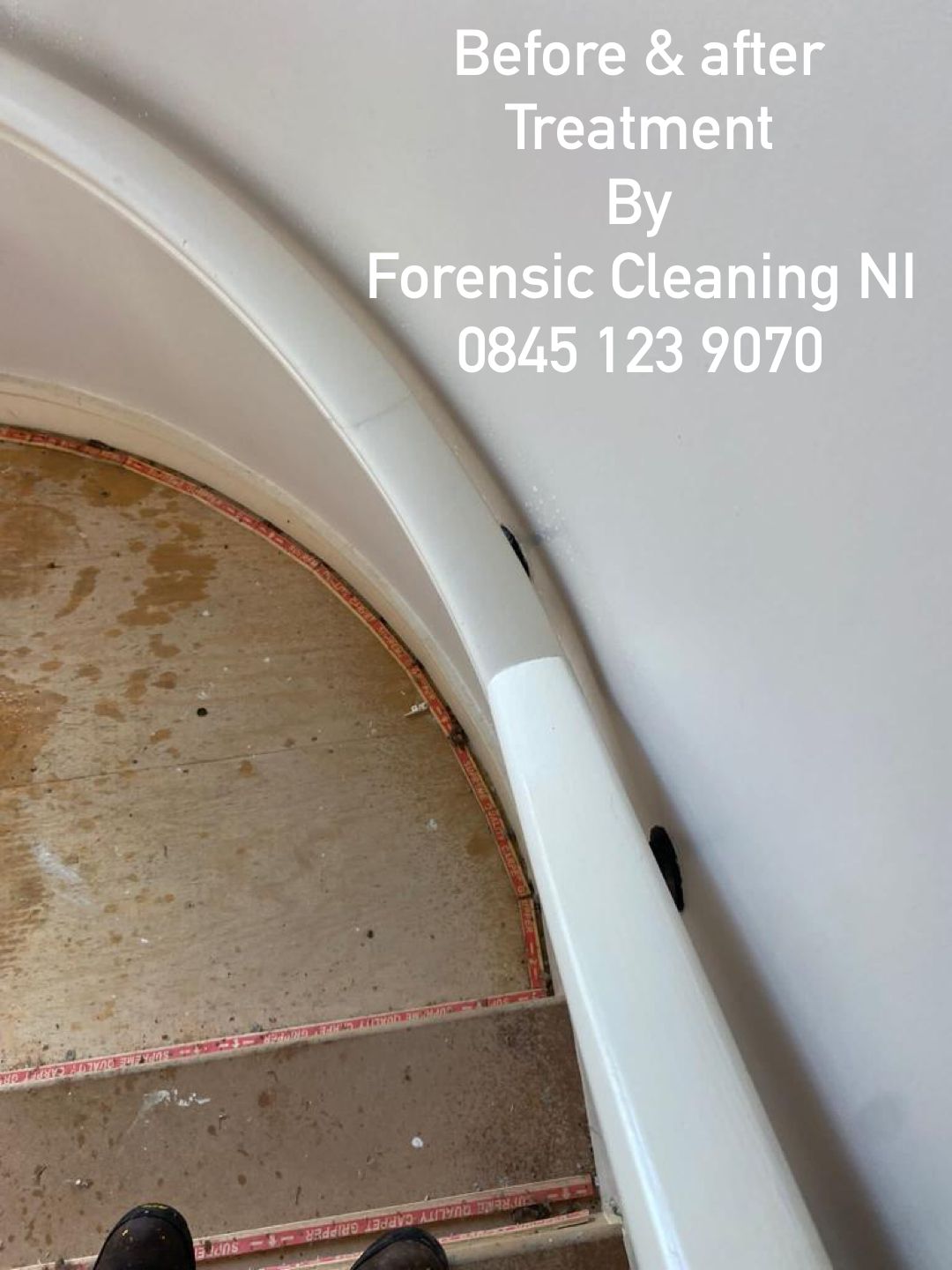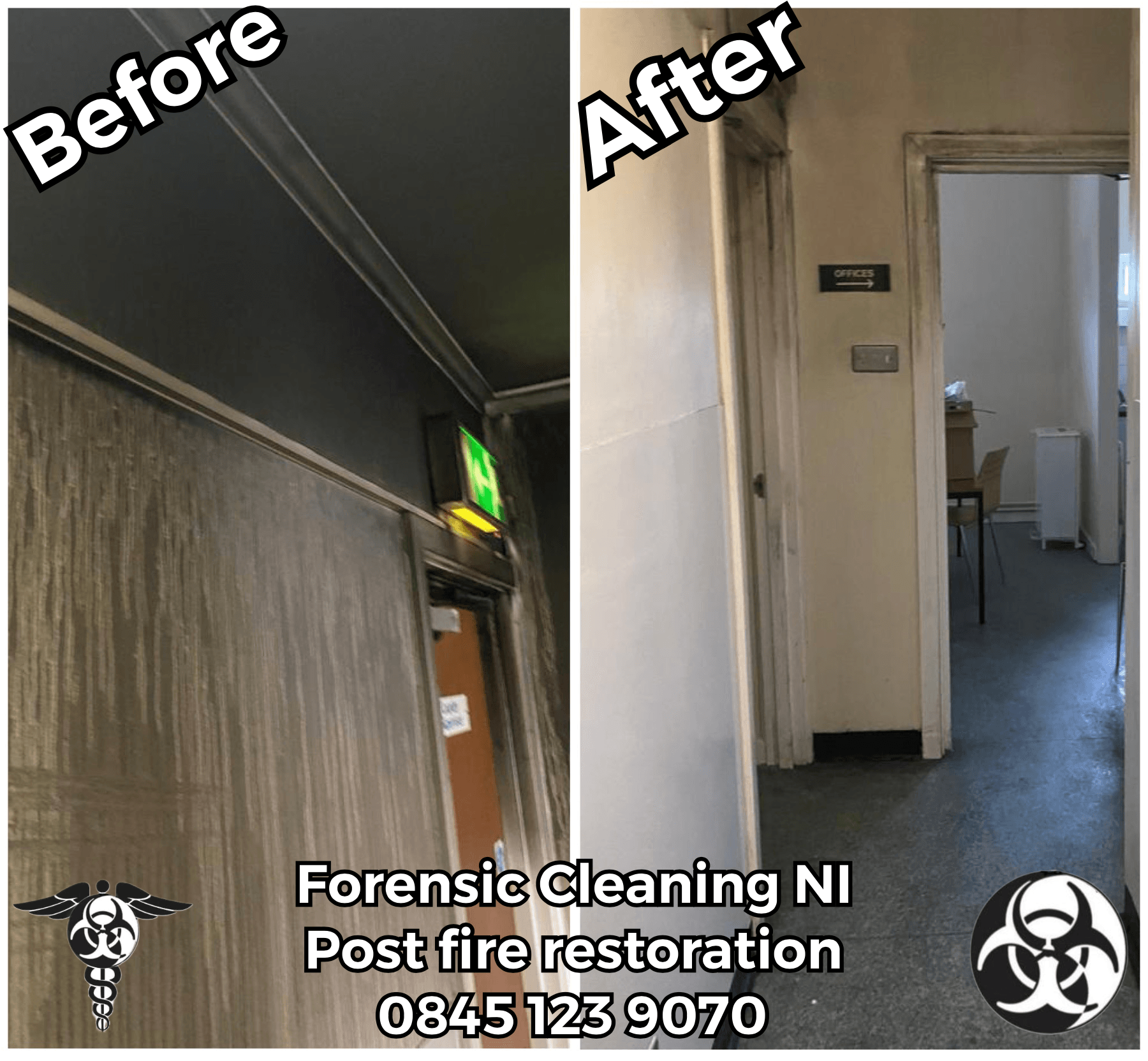Fire & Flood
Smoke or water damage creates serious issues
Forensic Cleaning NI: Water Extraction Services using state of the art clear & black water suction equipment:
- Rapid extraction of water to helps reduce secondary damage.
- Reduces business interruption.
If you have experienced flood or an escape of water (Clear/Black/Brown), removing the standing water efficiently as possible is crucial.
Standing water will seep into the construction and services of the building structure, but if left to sit, greywater can quickly turn into blackwater. Blackwater has many hazardous pathogens & bacteria creating another risk.
Whether you’ve been victim to a burst water main, body fluids, burst sewer, an overflowing river, or an uncontrollable leak within your property, or a neighbouring property swift action helps reduce secondary damage.
Across Northern Ireland our rapid response teams can be onsite within 2 hours of receiving instruction & 5 hours for the Republic of Ireland, our guys use bespoke industry leading technology and equipment to begin the water extraction & drying process.
Forensic Cleaning NI technicians are experienced and skilled in water extraction and every situation will be treated individually, ensuring the most efficient process for each individual incident. This means reduced disruption for you.
If standing or flood water doesn’t be extracted quickly the drying process becomes more difficult & subsequently takes longer & more expensive to remedy, mould cultivates then becomes a real health hazard, the integrity of your property becomes compromised & becomes a serious health hazard

FAQ: Water Extraction Services.
- Can water be removed from a building?
Water extraction is the process of removing water from an internal area, most usually standing water caused from a recent flood or large spill incident involving burst water pipe, sewer pipe, leaking roof, neighbouring properties, or heating systems.
- Is water extraction expensive?
Pricing associated with water removal depends entirely on the location of the property, the type of water, the number of floors affected, floor covering & how much water needs to be removed. Once these details are established either by the client or following a site inspection we help provide costs.
- Why Forensic Cleaning NI?
We have around the clock access to portable generators, water suction machines, dehumidifiers, suitable chemicals, water pumps, high reach equipment, submersible pumps, hot air blowers.
- What risks are there after the water is extracted?
If the area has been exposed to sewage, bacteria or other hazards, these areas require decontamination/sanitisation after the water is removed. A deodorising process may be required following the removal of water. Subject to conditions & length of time area have been exposed to the fluid we can carry out a carpet cleaning process in tandem with the water extraction thus speeding up the reoccupation.
Smoke & Soot removal decontamination
Fixtures, fittings & furniture can be damaged to the point of needing disposal or specialist restoration but we often find our soot & smoke cleaning processes reduce the need for replacing them, this reduces the overall remediation costs less waste disposal overhead, less business disruption, less labour & obviously less reinstatement overhead.
Traditional soap and water does not effectively remove soot & smoke from affected surfaces, Forensic Cleaning NI often deals with the carbon soot by exposing it to a negative static charge which greatly reduces the adhesive/sticky qualities which makes soot so difficult to remove. By effectively removing the soot we help reduce the airborne health hazard & makes the reinstatement process swifter. Soot & ash are known for their carcinogenic properties & we all have a duty of care to reduce risks where possible.
Soot, smoke & fire cleaning is a complicated process. It may involve stripping out fire damaged building materials such as plaster board, electric fittings, insulation the safe & correct disposal of hazardous waste & the cleaning or uplifting & disposal of carpet, curtains, fabrics, furniture before the cleaning process even begins. Structures may be unsafe to enter & other hazards such as asbestos may create other risks this needs to be taken into consideration.
The positively charged Carbon particles penetrate all areas of the building. The acidic carbon becomes embedded in every surface which has a corrosive effect on everything it touches. The carbon Polymers are slow to burn as they disfigure then often melt into a thick sticky mass. During this process, decomposition products including harmful monomers are released. Structural damage is caused by intense heat on metal & other components compromising safety of the building.
The soot, ash & smoke produce chemical residues which include acidic soot, hydrocarbons, carcinogenic PAHs & heavy metals like lead. The fire combustion process releases harmful chemicals into the immediate & surrounding environment which can include asbestos & mercury in older buildings. These penetrate the materials & surfaces within the premises itself. Smoke particles enter the vent system & if left they remain for years resulting in lung irritation & respiratory problems.
With our deodorising and odour neutralisation process we help eliminate smells & odours via a chemical & electronic process.
We want to hear from you
Discuss our Fire & Flood service
We will get back to you as soon as possible
Please try again later
2 Hour Emergency Response Time
The content on this website is owned by FCNI Ltd. Do not copy any content (including images) without our consent.


